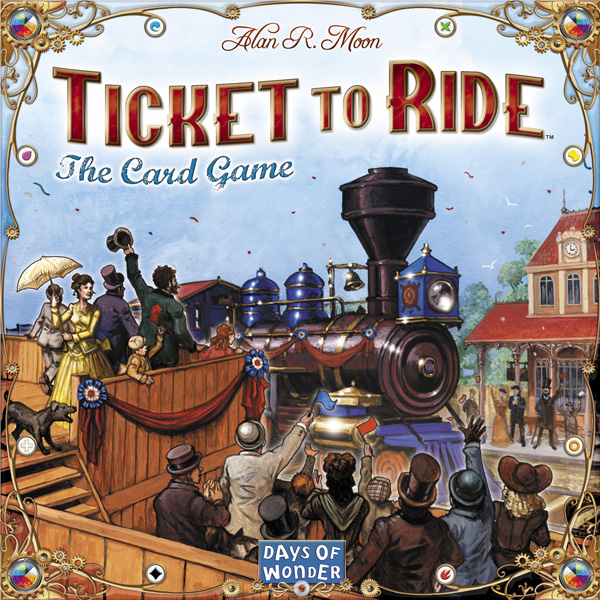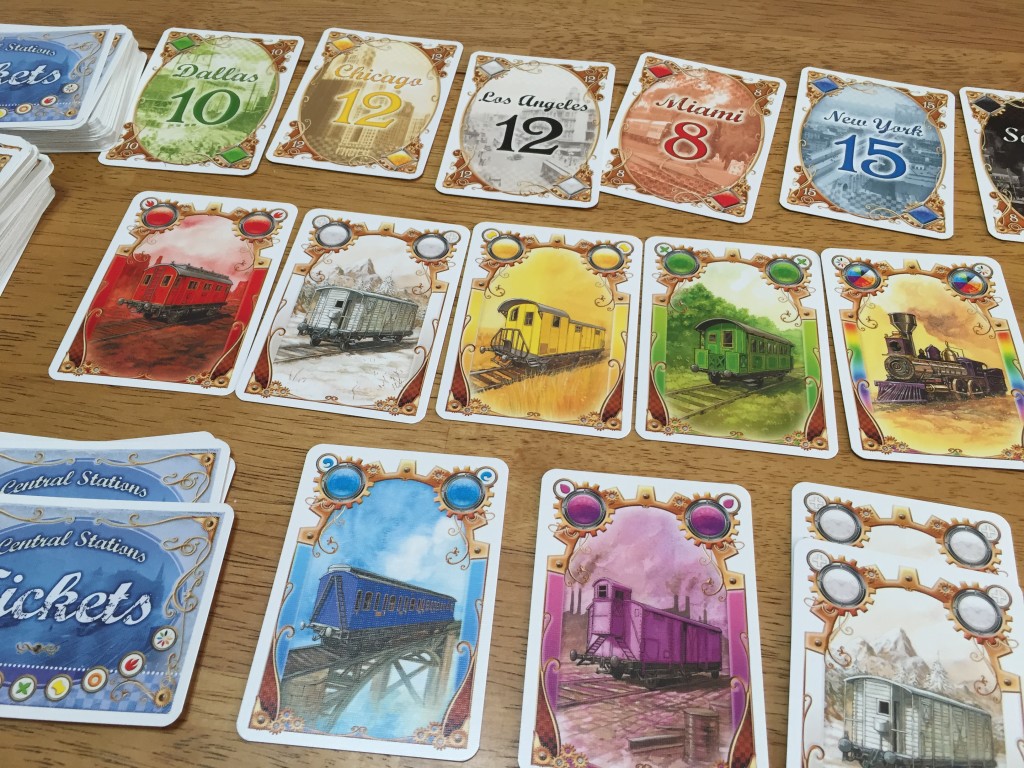No matter how many games I add to my collection, there’s always room in my closet for “Ticket to Ride”. I play it on the PC, I play it on the Xbox 360, and when the family is in the mood, we bust out the board game. Needless to say I’m a big fan of the game…it’s just so simple to play. I just wish the expansions weren’t so pricy, but I’ll get to that in my upcoming review of the UK map expansion. Today we’ll be looking at a smaller version of “Ticket to Ride”, condensed into card form. Does it hold up to the original? Keep reading to find out!

Ticket to Ride: The Card Game – 2-4 Players, Ages 8+, Average Play Time = 30 Minutes
Components
The game includes 96 train cards, 6 big city bonus cards, 46 destination tickets, and a rulebook.
Setup & Gameplay
Each player receives one locomotive (wild) card, then the train deck is shuffled with each player getting seven cards. Five cards are drawn from the deck face-up to form a pool. Each player receives six destination tickets from the shuffled deck and must keep at least one. Unwanted tickets are shuffled back into the ticket deck. The big city cards are placed off to the side. The youngest player goes first, with play proceeding clockwise.
A player’s turn consists of two steps:
1. The player will take one card from each colored row in their rail yard and place them face-down into their “On-The-Track Stack”. These cards remain there until the train deck runs out and its time to score tickets. Players may not look at their own pile, though you are free to break that rule for younger/inexperienced players or for those with a terrible memory.
2. The player will perform one of three actions: A) draw two train cards (deck or face-up cards), B) Place a suit of two or more cards or three cards of different colors into their railway, into piles sorted by color, C) draw four destination tickets, keeping as many as they want (they can discard them all). With regards to the second action, the player cannot play colors already present in their rail yard until they have no more of that color present. In addition, a player cannot play a color shown in another person’s rail yard UNLESS they play more cards than their opponent has in front of them. The opponent, in that case, discards the cards of that color (called train robbing).
Turns continue until the train deck runs out. When this happens, everyone gets one final turn, including the player who drew the last card from the deck. Players then go through their “On-The-Track Stack” to complete as many destination tickets as possible (the tickets will tell the player how many of a particular color are needed). Players with uncompleted tickets subtract their value from their calculated total. In addition, the player with the most completed destination tickets to each of the Big Cities, (Seattle, Los Angeles, Chicago, Dallas, New York and Miami) receives the Bonus card for that city and adds the points on that Bonus card to their score. The player with the most points, wins!
Editor’s Note: The above doesn’t cover all of the rules found in the manual, but should give you an idea as to how the game is played. For example, a four player game has two scoring rounds, meaning they’ll go through the train deck twice.

The Review
I have to admit, “Ticket to Ride: The Card Game” ended up playing a lot differently than I expected. You’re essentially trying to get cards into a score pile (the “On-The-Track-Stack”) so that you can use them to complete destination tickets during scoring. The hard part is getting the cards to your rail yard in the first place, which in turn allows you to put them into said score pile. The restrictions of not being able to play cards of a color you already have in your rail yard is limiting and so is the rule that you CAN place a color down your opponent has but only if lay down more than they have. In the end, it comes down to a battle for colors since only one color can be present in any rail yard at one time…and you may need said color to complete destination tickets.
While I prefer the board game over this, “Ticket to Ride: The Card Game” remains enjoyable enough to play on a regular basis when schedules are tight. It retains a lot of the mechanics of the core game, making it very easy to jump into assuming you already own “Ticket to Ride” or “Ticket to Ride: Europe”. I’ve seen this game sold on Amazon for about $15-$20, making it an easy recommend for any “Ticket to Ride” fan…just be forewarned that some may find it a step down from what they’re used to (especially those who prefer the more complicated “Ticket To Ride: Europe” edition).
Final Verdict: 7/10
—
